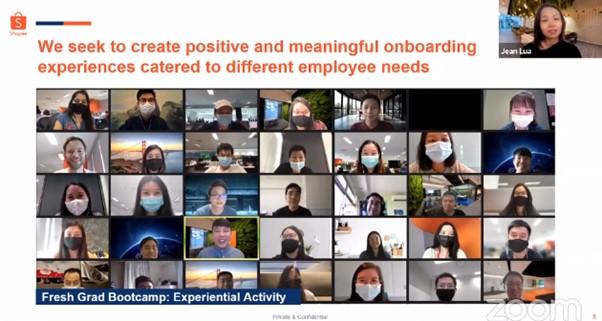Upskilling and reskilling key in shaping the future of L&D

With the pace of change accelerating in the last twenty years, many jobs have become obsolete, even as new ones have been created. This in turn, has made multi-skilling and future-proofing employees more critical than ever.
For DBS Bank, 1,200 employees have been upskilled and reskilled since 2016, revealed Joanne Hor, Chief Learning Officer, Group Human Resources, DBS Bank.
During her keynote presentation on Day 2 of Learning Technologies Asia 2021, Hor shared insights into DBS Bank’s upskilling and reskilling journey, including the launch of the DBS SkillsFlex programme designed for personal development, future skills and languages.
The journey continued with the DigiFY digital curriculum in 2017, which helped employees upskill for a digital age surrounding key pillars such as work agility, which was placed into sharper focus with the onset of the pandemic last year.
Continue to be agile, adapt and embrace the new normal, urged Hor, while highlighting how technology proved to be a key enabler for remote work across DBS Bank, even as a digital and change mindset allowed the organisation to pivot successfully into a post-pandemic world.
In Asia-Pacific, the pandemic has accelerated the digital transformation, observed Benny Ramos, Director, Global Solution Practice, Skillsoft, who identified the top drivers for digital transformation in the region as agility, customer experience, innovation and automation.
Alongside change however, comes the risk of jobs being lost, he added, citing the World Economic Forum, which has predicted that 50-60% of jobs that individuals will be doing in 2030 have not even been created yet.
This is further exacerbated by job replacements caused by the emergence of technologies such as artificial intelligence (AI) and machine learning. The best way to mitigate these developments, suggested Ramos, is to increase reskilling and upskilling, which is still somewhat lacking for many organisations.
Citing research from Vanson Bourne, he highlighted how 85% of employees wished their employer offered more news skills training in 2020, while 25% feared for their future employability because of a lack of skills.
While digital transformation and evolution will continue as more technologies are implemented, a successful transformation will centre around not just technology, but also an organisation’s talent, Ramos concluded.
For Sinar Mas Land, one core value stems from the belief that continuous improvement and loyalty will bring the company further when facing an agile age. At an uncertain time when organisations are rethinking work and how to improve work, this takes on more relevance, suggested Roby Tatan, Head of Learning & Development, Sinar Mas Land, Indonesia.
Citing a survey from the Harvard Business Review, he highlighted how 1,125 out of 1,500 (75%) managers from across 50 organisations are dissatisfied with their company’s L&D function. To address this gap, Tatan advised organisations address the shift in the role of L&D by designing individual development programmes that allow each employee to embark on their own learning and development journey.
READ: L&D driving organisational growth in a new world of work
At Shopee, the employee experience is at the heart of their talent strategies, where there is a focus on employee needs and building experiences to allow employees to learn and thrive, shared Jean Lua, Regional People Team, Shopee.
For instance, the Shopee Academy helps to not only make learning more practical and scalable, but also involves managers and senior hires in the creating of L&D strategies. More than 75% of Shopee employees have attending trainings, with Lua identifying over 900 managers who are committed to supporting and contributing to Shopee’s learning culture.
Shopee is also gradually moving towards a virtual learning environment, with initiatives such as learning experimental games that help build a culture of mentoring and coaching within the organisation.
And as Shopee continues its learning and engagement journey, Lua revealed that the best investment to make is in leadership involvement, and recognising how data will talk to you, if you are willing to listen. Lastly, she emphasised on the importance of simplicity, because while innovation is important, it is equally critical to keep things simple and easy to understand.
The future of learning in an era of capability-led transformation, is ‘invisible learning’, suggested Aek Ussivakul, Senior Vice-President, Learning Platform and Data, Siam Commercial Bank. This, however, does not lessen the need for learning; conversely, learning will become more important than ever.
He explained, “To make sure that we can learn all the time, learning has to be invisible. This means that learning cannot be just a workshop, or a course we attend. Learning has to be in every moment of our lives, and we need to create platforms that can match learning needs and solutions together.”
Ussivakul also identified the top trends that will have an impact on learning, including embed technologies such as Zoom, Teams and Google Meet. These applications, he explained, allows learning to take place anytime and anywhere.
AI, meanwhile, create more personalised learning for each individual, while technologies such as virtual reality (VR), augmented reality (AR) and mixed reality (XR) allows more immersive learning and the faster transfer of skills.
Over the coming weeks, look out for HRM Asia’s HR Leadership Series, which will guide you through all the challenges and opportunities as you navigate through 2021.



